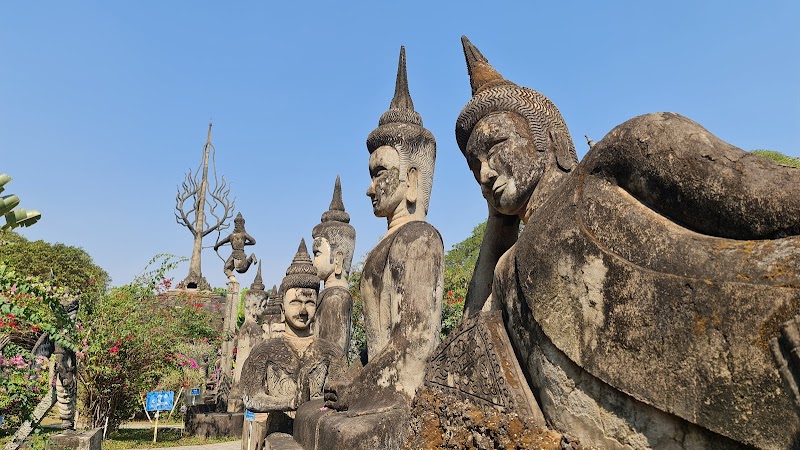
Red Lotus Festival Adventure: Exploring Udon Thani’s Blooming Wonder
Witness the fiery bloom of the Red Lotus Festival at Thung Si Mueang Lake in Udon Thani, Thailand. From December to February, this vibrant event invites visitors to explore vast pink waterscapes and engage with local traditions in a wetland rich with life.
Arrive Early for Peak Bloom
The lotus flowers are most open and vibrant during early morning hours before the midday heat causes them to close.
Wear Waterproof Footwear
The areas around the lake can be muddy, especially after rain, so sturdy waterproof shoes will keep you comfortable during your walk.
Carry Refillable Water Bottle
Hydration stations are limited and busy during peak festival days; bring your own water to stay hydrated.
Bring a Camera with Versatile Lens
Wide-angle lenses capture the lake’s sweeping floral carpet, while macro lenses get close to the lotus petal details and local wildlife.
Red Lotus Festival Adventure: Exploring Udon Thani’s Blooming Wonder
Every December through February, the sprawling Thung Si Mueang Lake near Udon Thani transforms into a lively sea of fiery blossoms at the Red Lotus Festival. The festival celebrates nature at its most vibrant, as thousands of red lotuses push through the still waters, daring visitors to immerse themselves in the floral spectacle. For travelers seeking an experience that balances outdoor exploration with cultural vibrancy, this festival offers a refreshing pulse of both.
The lake itself spans nearly 2000 hectares, making up a vast wetland where the red lotus shows off its fierce bloom under the winter sun. Walking paths and carefully developed piers invite you to move close enough to feel the thick petals brush the breeze yet maintain respect for the fragile ecosystem these flowers claim every year. While the terrain here is flat and accessible, the challenge comes in navigating the early morning crowds or making the 3-kilometer circuit around the lake’s edge — a gentle stroll that rewards with sweeping views of pink-hued waters and darting dragonflies.
Expect moist soil underfoot, especially after recent rainfall, so waterproof footwear is not just practical but necessary. As the sun climbs higher, the heat can push the lotus petals to close, turning down their vibrant display — best to plan visits around early morning hours when the flowers live their most open, defiant state.
Local vendors add flavor to the journey, selling fresh lotus tea, snacks, and crafts that echo the festival’s natural theme. For the adventurous, hiring a small boat is an option to slip quietly over the floral carpets, the gentle lapping of water pushing against the hull mimicking a whispered welcome.
Practical planning also includes hydration — water stands are scattered but can get busy, so bring your own bottle filled before arrival. Photography fans, pack a lens suitable for wide landscapes and close-up detail to capture both the expanse and the intricate petal patterns. Beyond flowers, the festival honors local traditions with folk music and dance performances that create a dynamic human rhythm around the floral calm.
Throughout this festival, the essence lies in interaction: between traveler and nature, visitor and local culture, quiet observation and lively celebration. Respect the lotus’s fragile kingdom and the community’s traditions to get the fullest measure of the Red Lotus Festival’s unique call. With simple preparation and open eyes, this adventure rewards with moments fiercely beautiful and practically unforgettable.
Nearby Trips
All Adventures
Boat Charters
Water Activities
Adventures near Udon Thani, Thailand
Discover the unique and memorable adventures that make Udon Thani, Thailand special.
Frequently Asked Questions
Where is the best spot to view the red lotus bloom?
The northern piers of Thung Si Mueang Lake offer an excellent vantage point, slightly away from the busiest areas, providing unobstructed views and ideal lighting especially in the morning.
Are boats available for touring the lake during the festival?
Yes, local operators provide small boat rentals that allow you to float quietly among the red lotus beds, offering a closer and more immersive perspective.
Is the Red Lotus Festival suitable for children and elderly visitors?
Absolutely. The terrain is flat and accessible, with gentle walking paths and rest areas. Early arrival can help avoid midday heat that can affect sensitive visitors.
What wildlife might I encounter during the festival?
Besides the blooming lotuses, watch for dragonflies skimming the water surface, migratory birds taking refuge in the wetlands, and occasional freshwater fish darting beneath the lilies.
Are there any cultural events tied to the festival?
Local communities host traditional Thai dance and folk music performances alongside the floral displays, blending cultural celebration with natural beauty.
How can I contribute to conserving the festival’s natural environment?
Visitors should stay on designated paths, avoid picking flowers, minimize plastic waste, and respect local wildlife to preserve this delicate ecosystem.
Recommended Gear
Waterproof Hiking Shoes
Keeps feet dry when walking near marshy shorelines and after rain.
Wide-brim Hat
Protects from strong sun during midday hours when the flowers begin to close.
Refillable Water Bottle
Stay hydrated throughout your visit; facilities may not always be accessible.
Camera with Zoom and Macro Lens
Capture the broad floral views and the detailed textures of blooming lotuses and lake wildlife.
Local Insights
Hidden Gems
- "Quiet viewing platforms on the lake’s eastern edge often overlooked by larger groups."
- "Nearby small temples offer serene spots for reflection amid peaceful rural surroundings."
Wildlife
- "Common sightings include black-capped kingfishers, marsh frogs, and Asian water monitors."
- "Seasonal migration brings rare bird species occasionally, adding surprises for birdwatchers."
History
"The Red Lotus Festival began as a community effort to celebrate and protect Thung Si Mueang Lake’s unique ecosystem. Over time, it grew into a major tourist event preserving local traditions and supporting wetland conservation."
